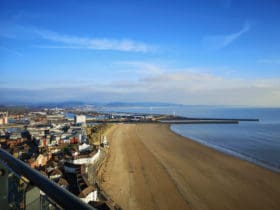Radical new plans to create a dragon-shaped floating “energy island” which will bring up to 10,000 new homes to Swansea would put the city “in the vanguard of global renewables innovation” – but the project could be sunk unless the Welsh Government can find millions of pounds in new funding, according to a property expert.
[aoa id=”1″]
The Dragon Energy Island project is a renewed attempt to harness the tidal power of Swansea Bay and would feature floating, modular housing plus new retail units, an underwater data centre and a solar farm.
Dragon Energy Island is the brainchild of Malcolm Copson of Hong Kong-based MOI Imagineering, who has previously been involved in showpiece developments such as Atlantis the Palm in Dubai and Disneyland Paris.
Previous attempts to create a £1.3 billion tidal lagoon by constructing a concrete wall with turbines to generate low-carbon electricity, are on hold after Government ministers rejected the idea of subsidising the project last year.
[/aoa]
Alex Van Den Bogerd, of the industrial and logistics team at global real estate advisor Colliers International, says Dragon Energy Island would deliver an enormous boost to the South Wales economy – but says Brexit puts an additional question mark over the project.
“Dragon Energy Island is ambitious, exciting idea which would really put Swansea on the map. It would provide power to around 150,000 homes and put the city and the wider region in the vanguard of global renewables innovation,” he said.
“However the tidal lagoon project also ran up against the realities of cost considerations and the bottom line is that none of these proposed tidal schemes are likely to go ahead unless the Welsh Government is able to provide substantial financial resources.
“This is further complicated by the fact that a large proportion of previous funding for Welsh infrastructure projects has come from the EU and it is unclear how any future funding will be made available after our projected Brexit departure on October 31.
“The UK Government has previously stressed the importance of creating new renewable energy but they have not been willing to commit any sort of funding thus far.
“Dragon Energy Island would be around 30 per cent cheaper than the original tidal lagoon scheme but the funding would have to be secured by a combination of bank loans, equity from the private sector and commitments from the Welsh Government, so I suspect the onus will be on the latter to fund the lion’s share of the cost.”
The Welsh Government aims to generate 70 per cent of electricity from renewable sources, including tidal energy, by 2030.








Leave a Reply
View Comments